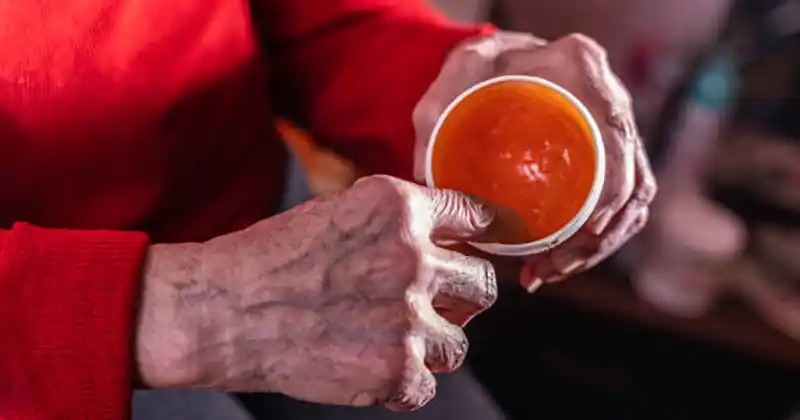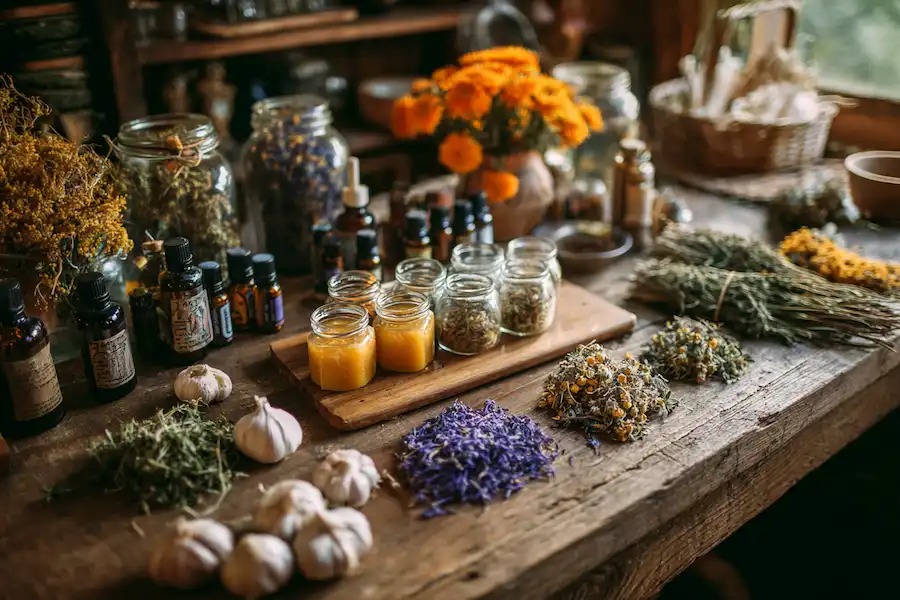In your pantry or garden lie powerful antibacterial allies: garlic, thyme, calendula, lavender, and more. Combined into a soothing salve, they can offer a botanical boost for minor wounds, scrapes, and cuts.

Why Go Natural?
- Broad-spectrum antibacterial action
Herbs like garlic, thyme, oregano, and lavender contain compounds—such as allicin, thymol, and carvacrol—that show strong antimicrobial effects in studies. - Effective wound care
Calendula and chamomile bring anti-inflammatory and healing qualities beneficial for skin repair. - Accessible and DIY-friendly
These plants are commonly grown or purchased, enabling anyone to craft an ointment without specialty ingredients.
What You’ll Need
- Herbal base – choose one or more
- Calendula petals (dry or fresh),
- Lavender flowers,
- Thyme sprigs,
- Garlic (crushed),
- Chamomile or similar soothing herbs.
- Carrier oil – olive, coconut, or sweet almond oil work well.
- Beeswax – solidifier to give texture.
- Essential oils (optional) – tea tree, lavender, oregano, or thyme for extra potency.
- Vitamin E oil (optional) – acts as preservative and skin conditioner.
- Sterile jars or tins – for storage.

Step-by-Step Guide
1. Make an Herbal-Infused Oil
- Lightly dry your herbs to prevent mold.
- Fill a clean jar with herbs, cover fully with carrier oil.
- Close and store in a cool, dark place for 4–6 weeks, shaking daily.
- Strain through cheesecloth—you now have potent herbal oil
2. Prepare the Ointment
- In a double-boiler, melt about 1 cup infused oil with ¼ cup beeswax pellets (adjust for desired firmness).
- Once melted, remove from heat.
3. Enhance with Essential Oils
- As mixture cools slightly (but still liquid), stir in:
- 15–20 drops tea tree oil,
- 10–15 drops lavender oil,
- 5–10 drops oregano or thyme oil,
- Optional: ½ tsp vitamin E oil.
- Stir well for even distribution
4. Jar & Cure
- Pour into sterilized containers; allow to cool and firm.
- Label with date. For best potency, use within 6–12 months.
Usage & Benefits
Use the salve on clean minor cuts, scrapes, insect bites, or dry, cracked skin—much like you would apply Neosporin. Keep wounds clean, apply a thin layer, cover if needed.
Benefits include:
- Antimicrobial: garlic, thyme, oregano fight bacteria (e.g., Staph, E. coli).
- Anti-inflammatory & wound-healing: calendula and chamomile soothe and aid repair.
- Safe and gentle: ideal for most skin types; avoid essential oils in infants or sensitive skin.
Precautions
- Avoid use on deep or infected wounds—consult a healthcare provider.
- Essential oils are potent—patch-test first and dilute; sensitive individuals may react.
- Honey-based salves are effective in medical settings, but this oil-based version works well for everyday care .
Disclaimer:
This ointment is a natural, homemade remedy intended for minor skin irritations, cuts, or scrapes. It is not a substitute for professional medical treatment, antibiotics, or advice. Always consult a qualified healthcare provider for serious wounds, infections, or if symptoms persist. Use at your own discretion. This content is for educational and informational purposes only.
Final Recipe Snapshot
| Ingredient | Amount |
|---|---|
| Herbal-infused oil | 1 cup |
| Beeswax pellets | ¼ cup |
| Tea tree essential oil | 15–20 drops |
| Lavender essential oil | 10–15 drops |
| Oregano or thyme oil | 5–10 drops |
| Vitamin E oil (optional) | ½ teaspoon |
Melt oil + beeswax → blend in essential oils → pour into containers → use on minor wounds.

This homemade antibiotic ointment blends science-backed plants with easy preparation—offering a natural, effective option for minor skin wounds. It’s DIY-friendly, herbal-powered, and rewarding to make. Just remember: it’s a natural aid, not a substitute for professional medical care when infections are deep or severe.
